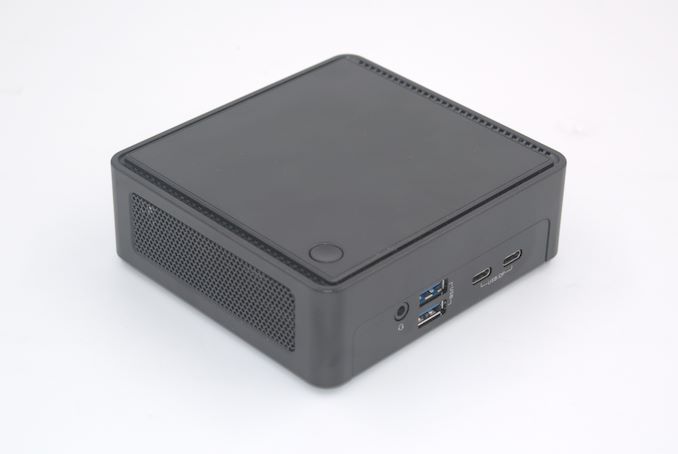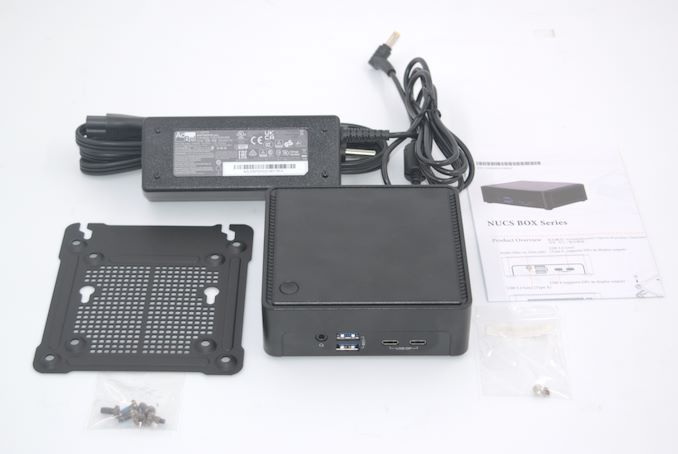Low-power processors have traditionally been geared towards notebooks and other portable platforms. However, the continued popularity of ultra-compact form-factor desktop systems has resulted in UCFF PCs also serving as lead vehicles for the latest mobile processors. Such is the case with Intel’s Raptor Lake-P – the processor SKUs were announced earlier this month at the 2023 CES, and end-products using the processor were slated to appear in a few weeks. Intel is officially allowing its partners to start selling their products into the channel today, and also allowing third-party evaluation results of products based on Raptor Lake-P to be published.
ASRock Industrial introduced their Raptor Lake-P-based NUC clones as soon as Intel made the parts public. With the new platform, the company decided to trifurcate their offerings – a slim version (sans 2.5″ drive support) with DDR4 SODIMM slots in the NUCS BOX-13x0P/D4, a regular height version with 2.5″ drive support in the NUC BOX-13x0P/D4, and a slightly tweaked version of the latter with DDR5 SODIMM slots in the NUC BOX-13x0P/D5. The NUCS BOX-1360P is the company’s flagship in the first category, and the relative maturity of DDR4-based platforms has allowed them to start pushing the product into the channel early.
ASRock Industrial sampled us with a NUCS BOX-1360P/D4 from their first production run. We expected a run of the mill upgrade with improvements in performance and power efficiency. In the course of the review process, we found that the system allowed control over a new / key Raptor Lake-P feature that Intel hadn’t even bothered to bring out during their CES announcement – in-band ECC. This review provides a comprehensive look at Raptor Lake-P’s feature set for desktop platforms along with with detailed performance and power efficiency analysis for SFF PC workloads.
Introduction and Product Impressions
Intel’s Raptor Lake-P builds upon Alder Lake-P and its heterogeneous processor architecture by moving to a more efficient manufacturing process. Unlike the desktop version with improved cache size per performance core and doubled efficiency cores count, the -P series provides improvements essentially from the updated V-F curves. This has allowed Intel to increase the turbo clocks for both core types to deliver better performance and power efficiency – all while retaining the same 28W nominal TDP of Alder Lake-P. There are also a number of I/O improvements such as additional Thunderbolt 4 ports and USB 3.2 Gen 2×2 support on them, but the adoption of those are dependent on other board component choices by the system manufacturer.
ASRock is a well-known vendor in the consumer PC market. In 2011, the company set up the ASRock Industrial business unit to focus on industrial motherboards. The division branched out in 2018 as an independent vendor with exclusive focus on B2B products. The company has products for deployment in small businesses (offices), automation, robotics, security, and other industrial / IoT applications. Primarily, the company develops motherboards, and sells them to various system integrators who can do their own value additions. Additionally, the company also sells mini-PCs based on the developed motherboards into the retail channel. We have taken a close look at the performance profile of various ASRock Industrial UCFF PCs before, including that of the NUC BOX-1260P based on the Core i7-1260P Alder Lake-P processor.
The company provided us with a sample of their first Raptor Lake-P mini-PC – the NUCS BOX-1360P/D4. This is essentially a follow-up product to the NUC BOX-1200 series, but not exactly a drop-in replacement. While the NUC BOX-1200 series came with dual LAN capabilities, and a choice of both HDMI and Display Port outputs, the NUCS BOX-1300 series replaces the Display Port output with another HDMI port and does away with one of the LAN ports.
While the NUC BOX series uses a chassis tracing its roots back to ASRock’s now defunct Beebox product line, the NUCS BOX is a first for ASRock Industrial. Without the need to support a 2.5″ drive, the chassis height has been cut down from 48mm to 38mm. The original fingerprint magnet of a chassis top has also been replaced with matte plastic. The relative distance between the motherboard and the chassis top has not been altered, though (the height reduction is completely on the underside where the 2.5″ drive caddy used to be placed). The cooling solution for the processor is time-tested within that case design, and all that ASRock Industrial has done for the NUCS BOX-1300 series is to alter the I/O cut-outs slightly to match the new board.
ASRock Industrial’s main focus is on B2B customers. It is no surprise that their systems are packaged in a nondescript manner. However, within the package, the company includes everything that an end-user would need – a VESA mount and associated screws, M.2 SSD installation aids, a geo-specific power cord and a 90W power adapter.
ASRock Industrial markets their mini-PCs in a barebones configuration, with the choice of RAM and SSD left to the end user. Installing these components involves removing four screws from the underside of the unit and slotting in the SODIMMs and affixing the M.2 SSD with a screw. It must be noted here that the M.2 SSD installation in the NUCS BOX-1360P is much easier compared to the NUC BOX-1200 series as the screw slot is directly on the board and not on a separate plastic tab. The side of the chassis are perforated for air intake and the rear has the air vent that allows the laptop-style blower fan to exhaust air after passing it through the heat spreader.
In order to make an apples-to-apples comparison, we opted to utilize the same set of components used in our review of the NUC BOX-1260P. The NUCS BOX-1360P/D4 was equipped with an ADATA XPG GAMMIX S50 Lite and 2x 32GB of the Kingston FURY Impact DDR4-3200 SODIMMs. The full specifications of our review sample (as tested) are summarized in the table below.
| ASRock NUCS BOX-1360P/D4 Specifications (as tested) |
|
| Processor | Intel Core i7-1360P Raptor Lake 4P + 8E / 16T, up to 5.0 GHz (P) up to 3.7 GHz (E) Intel 7, 18MB L2, Min / Max / Base TDP: 20W / 64W / 28W PL1 = 28W, PL2 = 64W |
| Memory | Kingston FURY Impact KHX3200C20S4/32GX DDR4-3200 SODIMM 20-22-22-48 @ 3200 MHz 2×32 GB |
| Graphics | Intel Iris Xe Graphics (96EU @ 1.50 GHz) |
| Disk Drive(s) | ADATA XPG GAMMIX S50 Lite (2 TB; M.2 2280 PCIe 4.0 x4 NVMe;) (Micron 96L 3D TLC; Silicon Motion SM2267 Controller) |
| Networking | 1x 2.5 GbE RJ-45 (Intel I226-LM) Intel Wi-Fi 6E AX210 (2×2 802.11ax – 2.4 Gbps) |
| Audio | Realtek ALC233 (3.5mm Audio Jack in Front) Digital Audio with Bitstreaming Support over HDMI and Display Port |
| Video | 2x HDMI 2.0b (Rear) 2x Display Port 1.4 over Type-C Alt-Mode |
| Miscellaneous I/O Ports | 1x USB4 Type-C (Front, up to 40 Gbps) 1x USB 3.2 Gen 2 Type-C (Front, with DP Alt Mode) 2x USB 3.2 Gen 2 Type-A (Front) 2x USB 3.2 Gen 2 Type-A (Rear) |
| Operating System | Windows 11 Enterprise (22000.1455) |
| Pricing | (Street Pricing on January 25th, 2022) US $700 (barebones) US $1050 (as configured, no OS) |
| Full Specifications | ASRock Industrial NUCS BOX-1360P/D4 Specifications |
In the next section, we take a look at the BIOS options along with an analysis of the motherboard platform. It also includes an overview of the in-band ECC feature that Intel had played down at launch. Following that, we have a number of sections focusing on various performance aspects with and without in-band ECC before concluding with an analysis of the value proposition of the system.


